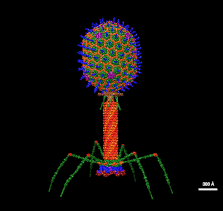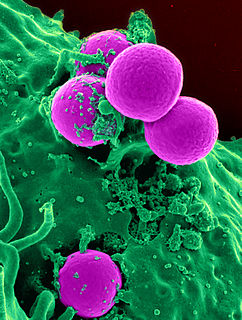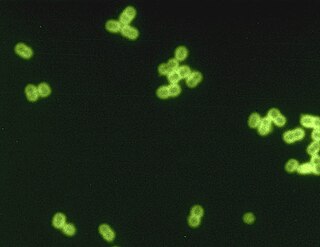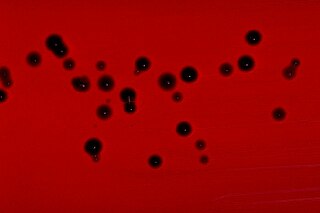Related Research Articles

An antibiotic is a type of antimicrobial substance active against bacteria. It is the most important type of antibacterial agent for fighting bacterial infections, and antibiotic medications are widely used in the treatment and prevention of such infections. They may either kill or inhibit the growth of bacteria. A limited number of antibiotics also possess antiprotozoal activity. Antibiotics are not effective against viruses such as the common cold or influenza; drugs which inhibit viruses are termed antiviral drugs or antivirals rather than antibiotics.

Antimicrobial resistance (AMR) occurs when microbes evolve mechanisms that protect them from the effects of antimicrobials. The term antibiotic resistance is a subset of AMR, as it applies to bacteria that become resistant to antibiotics. Resistant microbes are more difficult to treat, requiring higher doses, or alternative medications which may prove more toxic. These approaches may also be more expensive. Microbes resistant to multiple antimicrobials are called multidrug resistant (MDR).

A bacteriophage, also known informally as a phage, is a virus that infects and replicates within bacteria and archaea. The term was derived from "bacteria" and the Greek φαγεῖν, meaning "to devour". Bacteriophages are composed of proteins that encapsulate a DNA or RNA genome, and may have structures that are either simple or elaborate. Their genomes may encode as few as four genes and as many as hundreds of genes. Phages replicate within the bacterium following the injection of their genome into its cytoplasm.

Bacillus is a genus of Gram-positive, rod-shaped bacteria, a member of the phylum Firmicutes, with 266 named species. The term is also used to describe the shape (rod) of certain bacteria; and the plural Bacilli is the name of the class of bacteria to which this genus belongs. Bacillus species can be either obligate aerobes: oxygen dependent; or facultative anaerobes: having the ability to continue living in the absence of oxygen. Cultured Bacillus species test positive for the enzyme catalase if oxygen has been used or is present.

Methicillin-resistant Staphylococcus aureus (MRSA) refers to a group of Gram-positive bacteria that are genetically distinct from other strains of Staphylococcus aureus. MRSA is responsible for several difficult-to-treat infections in humans. MRSA is any strain of S. aureus that has developed or acquired a multiple drug resistance to beta-lactam antibiotics. Beta-lactam (β-lactam) antibiotics are a broad-spectrum group that include some penams and cephems such as the cephalosporins. Strains unable to resist these antibiotics are classified as methicillin-susceptible S. aureus, or MSSA.

Deinococcus–Thermus is a phylum of bacteria that are highly resistant to environmental hazards, also known as extremophiles. These bacteria have thick cell walls that give them gram-positive stains, but they include a second membrane and so are closer in structure to those of gram-negative bacteria. Cavalier-Smith calls this clade Hadobacteria.

Streptococcus pneumoniae, or pneumococcus, is a Gram-positive, spherical bacteria, alpha-hemolytic or beta-hemolytic, facultative anaerobic member of the genus Streptococcus. They are usually found in pairs (diplococci) and do not form spores and are non motile. As a significant human pathogenic bacterium S. pneumoniae was recognized as a major cause of pneumonia in the late 19th century, and is the subject of many humoral immunity studies.

Acinetobacter is a genus of Gram-negative bacteria belonging to the wider class of Gammaproteobacteria. Acinetobacter species are oxidase-negative, exhibit twitching motility, and occur in pairs under magnification.
Bacillary dysentery is a type of dysentery, and is a severe form of shigellosis.

Pseudomonas aeruginosa is a common encapsulated, Gram-negative, facultatively aerobic, rod-shaped bacterium that can cause disease in plants and animals, including humans. A species of considerable medical importance, P. aeruginosa is a multidrug resistant pathogen recognized for its ubiquity, its intrinsically advanced antibiotic resistance mechanisms, and its association with serious illnesses – hospital-acquired infections such as ventilator-associated pneumonia and various sepsis syndromes.

Staphylococcus epidermidis is a Gram-positive bacterium, and one of over 40 species belonging to the genus Staphylococcus. It is part of the normal human flora, typically the skin flora, and less commonly the mucosal flora. It is a facultative anaerobic bacteria. Although S. epidermidis is not usually pathogenic, patients with compromised immune systems are at risk of developing infection. These infections are generally hospital-acquired. S. epidermidis is a particular concern for people with catheters or other surgical implants because it is known to form biofilms that grow on these devices. Being part of the normal skin flora, S. epidermidis is a frequent contaminant of specimens sent to the diagnostic laboratory.

Chromobacterium violaceum is a Gram-negative, facultative anaerobic, non-sporing coccobacillus. It is motile with the help of a single flagellum which is located at the pole of the coccobacillus. Usually, there are one or two more lateral flagella as well. It is part of the normal flora of water and soil of tropical and sub-tropical regions of the world. It produces a natural antibiotic called violacein, which may be useful for the treatment of colon and other cancers. It grows readily on nutrient agar, producing distinctive smooth low convex colonies with a dark violet metallic sheen. Some strains of the bacteria which do not produce this pigment have also been reported. It has the ability to break down tarballs.

Acinetobacter baumannii is a typically short, almost round, rod-shaped (coccobacillus) Gram-negative bacterium. It is named after the bacteriologist Paul Baumann. It can be an opportunistic pathogen in humans, affecting people with compromised immune systems, and is becoming increasingly important as a hospital-derived (nosocomial) infection. While other species of the genus Acinetobacter are often found in soil samples, it is almost exclusively isolated from hospital environments. Although occasionally it has been found in environmental soil and water samples, its natural habitat is still not known.

Mycobacterium abscessus complex (MABSC) is a group of rapidly growing, multidrug-resistant, nontuberculous mycobacteria (NTM) species that are common soil and water contaminants. Although M. abscessus complex most commonly causes chronic lung infection and skin and soft tissue infection (SSTI), the complex can also cause infection in almost all human organs, mostly in patients with suppressed immune systems. Amongst NTM species responsible for disease, infection caused by M. abscessus complex are more difficult to treat due to antimicrobial drug resistance.

Ramoplanin (INN) is a glycolipodepsipeptide antibiotic drug derived from strain ATCC 33076 of Actinoplanes.
Streptomyces antibioticus is a gram-positive bacterium discovered in 1941 by Nobel-prize-winner Selman Waksman and H. Boyd Woodruff. Its name is derived from the Greek "strepto-" meaning "twisted", alluding to this genus' chain-like spore production, and "antibioticus", referring to this species' extensive antibiotic production. Upon its first characterization, it was noted that S. antibioticus produces a distinct soil odor.
Deinococcus deserti is a Gram-negative, rod-shaped bacterium that belongs to the Deinococcaceae, a group of extremely radiotolerant bacteria. D. deserti and other Deinococcaceae exhibit an extraordinary ability to withstand ionizing radiation.
Verrucosispora is a bacterial genus from the family of Micromonosporaceae. Verrucosispora produces abyssomicins.
"Paramesorhizobium" is a provisional genus of bacteria from the family Phyllobacteriaceae with one known species.
Saccharopolyspora deserti is a halotolerant bacterium from the genus of Saccharopolyspora which has been isolated from sand from Saudi Arabia.
References
- 1 2 3 "Paramesorhizobium deserti". www.uniprot.org.
- ↑ Lv, Ruichen; Yang, Xianwei; Fang, Nan; Song, Yuqin; Luo, Xuesong; Guo, Jingyu; Peng, Fang; Yang, Ruifu; Cui, Yujun; Fang, Chengxiang; Song, Yajun (28 April 2016). "Draft Genome Sequence of "Paramesorhizobium deserti" A-3-ET, a Strain Highly Resistant to Diverse β-Lactam Antibiotics". Genome Announcements. 4 (2): e00311-16. doi:10.1128/genomeA.00311-16. PMC 4850856 . PMID 27125485.